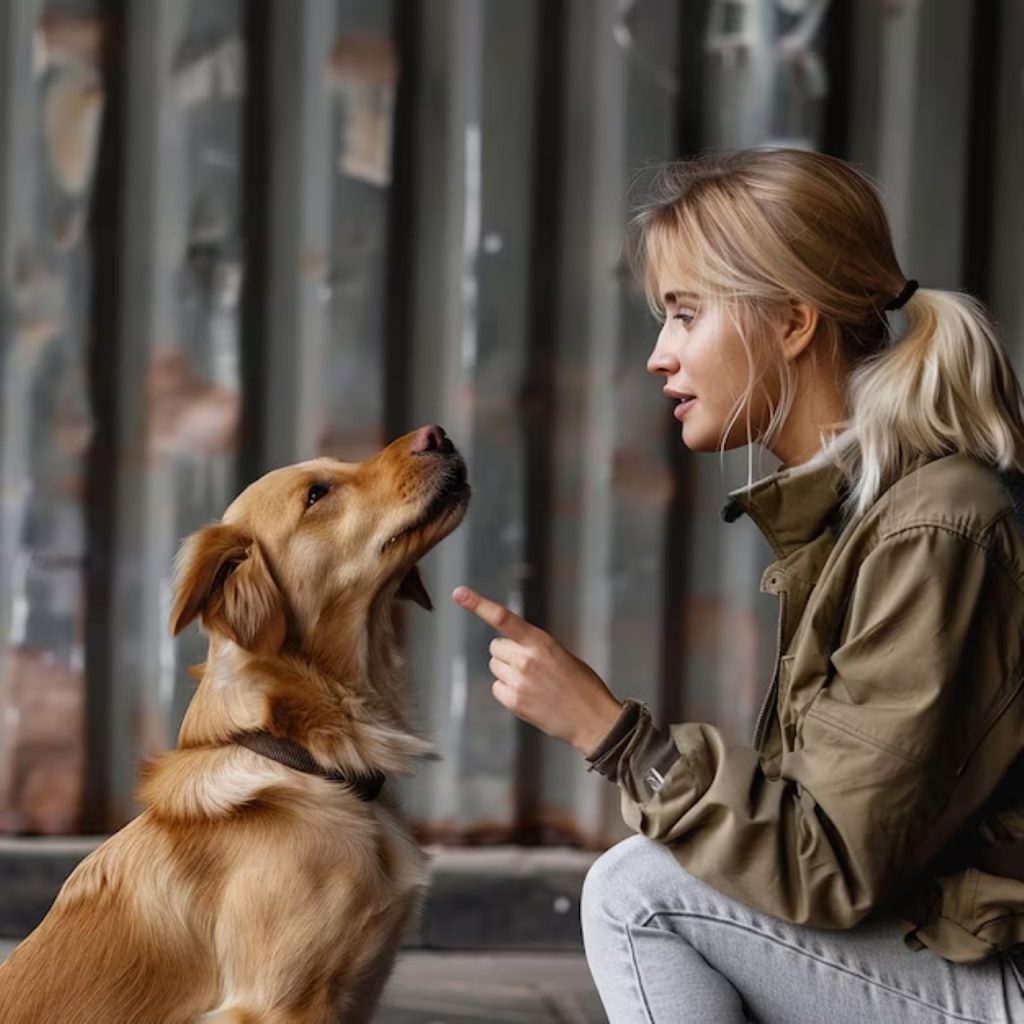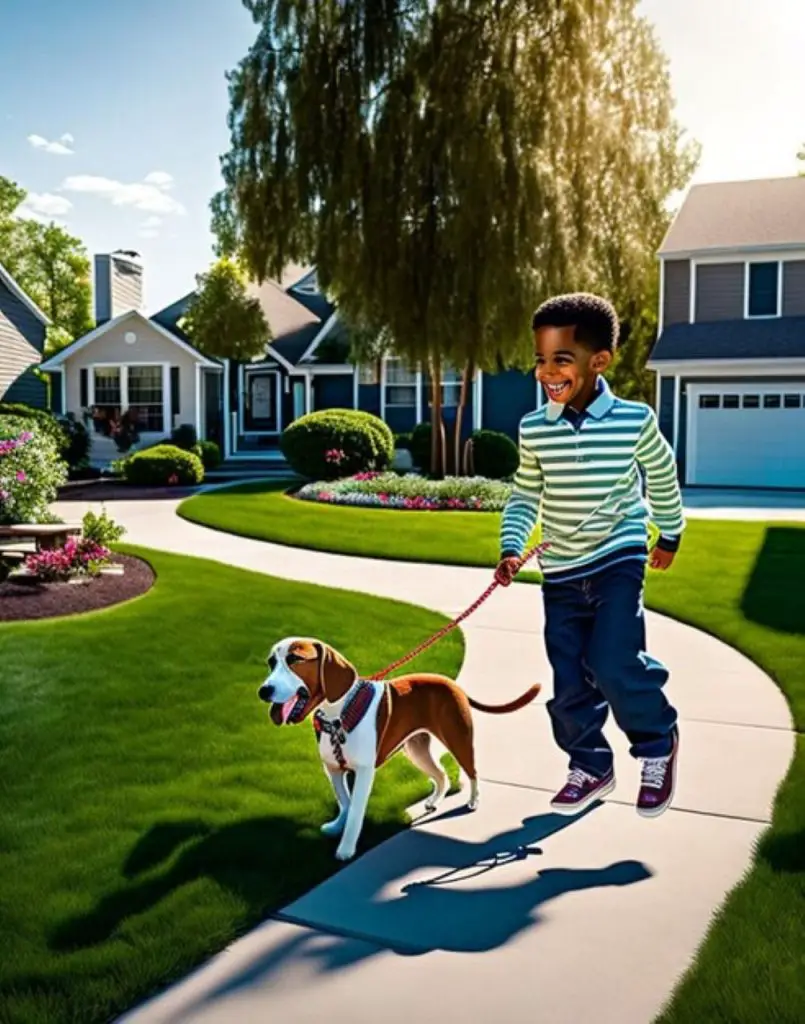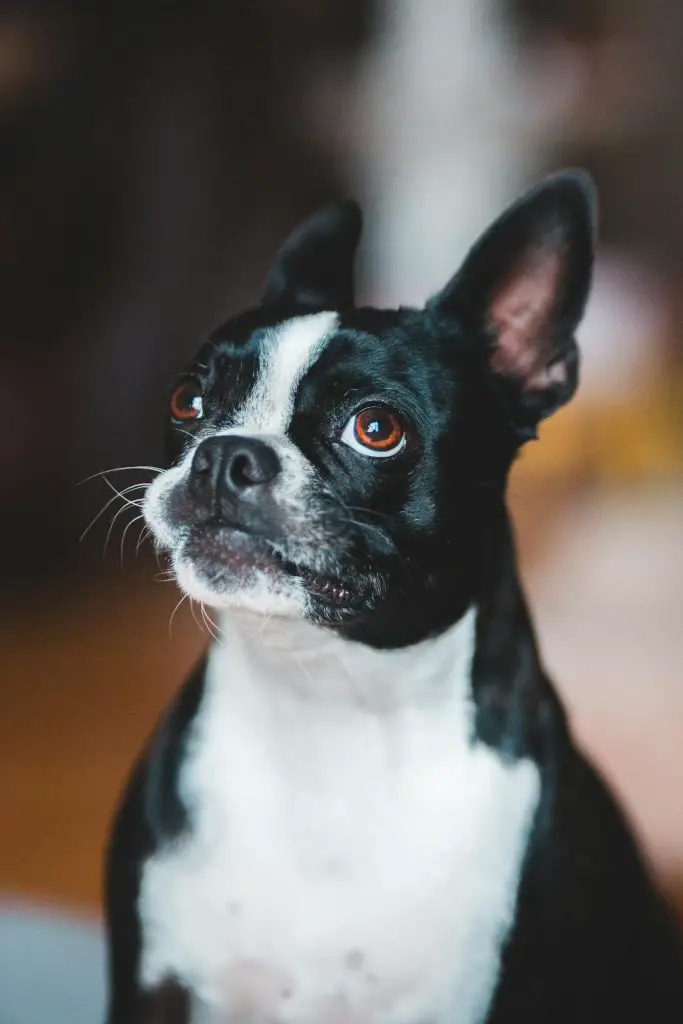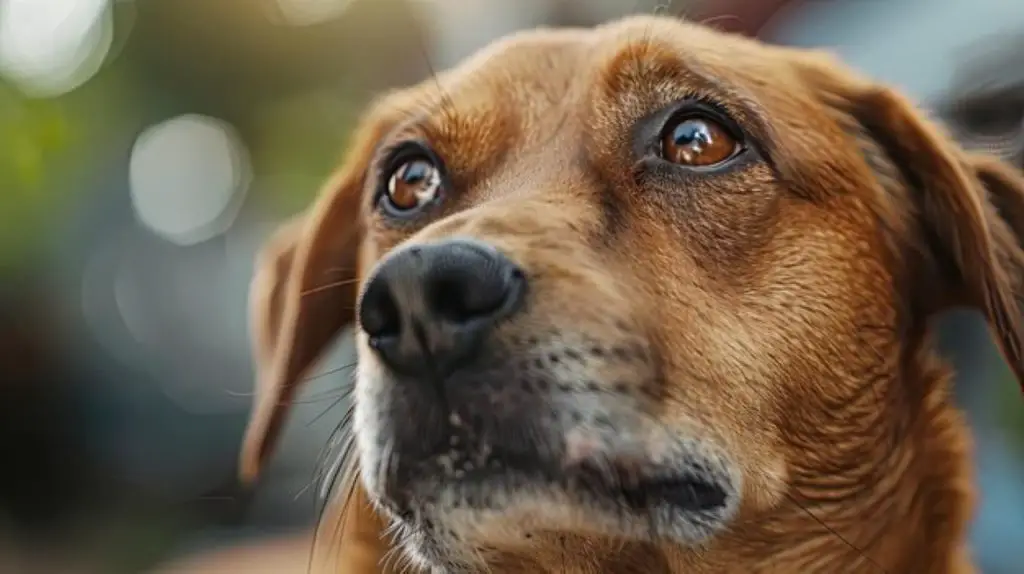
Training a blind dog requires patience and adaptation. Focus on their heightened senses of hearing, smell, and touch. Create a safe, consistent environment with tactile markers and scent cues. Use clear verbal commands paired with gentle touch signals for guidance. Implement scent-based techniques to help your dog navigate and learn. Establish a routine to build confidence and security. Adapt common training exercises by incorporating sound markers and physical guidance. Socialize your blind dog gradually, allowing them to explore new environments at their own pace. With the right approach, you’ll reveal your blind dog’s full potential and strengthen your bond.
Table of Contents
Key Takeaways

- Establish clear verbal commands and touch signals for consistent communication with your blind dog.
- Create a safe, obstacle-free environment with textured markers and scent cues for navigation.
- Develop routine paths and schedules to build confidence and security for your blind dog.
- Use scent-based training techniques to teach commands and engage in mentally stimulating activities.
Understanding Your Blind Dog’s Needs
To effectively train a blind dog, you’ll need to first grasp their unique requirements and challenges. Blind dogs rely heavily on their other senses, particularly hearing and smell, to navigate their environment.
As their owner, you’ll need to provide consistent emotional support and sensory enrichment to help them feel secure and confident.
Understanding your blind dog’s needs involves recognizing their reliance on routine. Establish a predictable daily schedule for feeding, walks, and playtime.
This consistency helps your dog feel more in control of their surroundings. You’ll also need to create a safe home environment by removing obstacles and maintaining a consistent layout.
This post contains affiliate links. However all the information provided on this site are my own honest opinions. See more in Disclaimer.
Communication is essential when training a blind dog. Use clear, verbal cues and gentle touch signals to guide them. Avoid sudden movements or loud noises that might startle them.
Instead, focus on positive reinforcement techniques, rewarding desired behaviors with treats and praise.
Sensory enrichment plays an important role in your blind dog’s well-being. Introduce toys with different textures and sounds to stimulate their remaining senses.
Regular exercise and mental stimulation through scent-based games can help keep your dog engaged and happy.
Creating a Safe Training Environment
Safety is paramount when training a blind dog, so you’ll need to create a secure and consistent environment for your sessions.
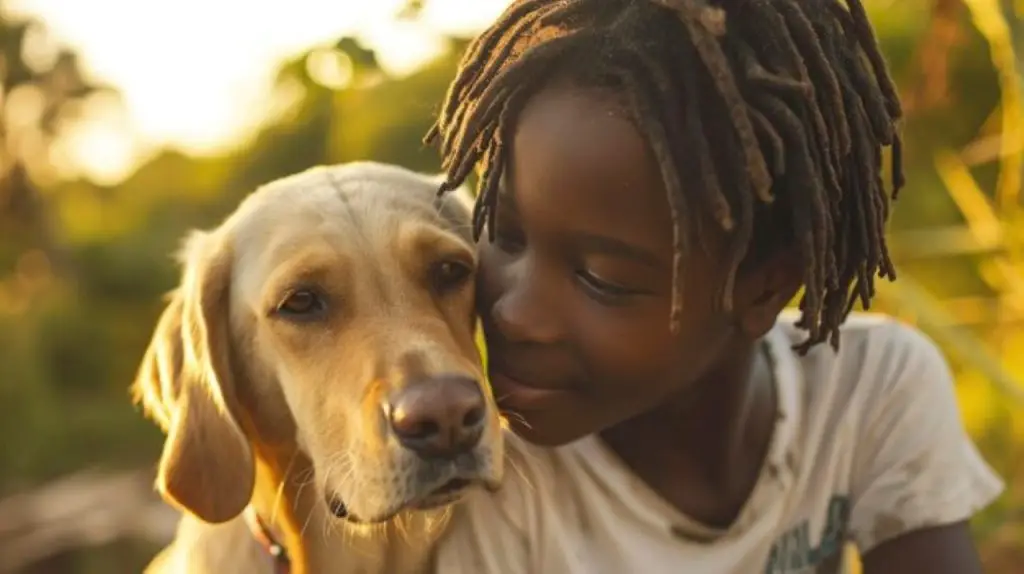
Start by designating a safe space for training, free from potential hazards like sharp edges or unstable furniture. Remove any objects that could trip or startle your dog, ensuring a clear path for movement.
Develop your dog’s obstacle awareness by introducing different textures and surfaces in a controlled manner. Use tactile markers like textured mats or rugs to help your dog identify specific areas.
Keep training tools and rewards in the same location to maintain consistency and reduce confusion.
Consider using scent cues to help your dog navigate the training area. Place familiar, pleasant-smelling objects at key points to create a sense of direction and comfort.
Use verbal cues consistently to guide your dog through the space and reinforce their understanding of the environment.
Minimize background noise during training sessions to help your dog focus on your commands.
Gradually introduce new elements to the training area as your dog becomes more comfortable, always prioritizing their safety and confidence.
Verbal Commands and Touch Signals

When training a blind dog, you’ll need to rely heavily on clear, consistent vocal cues and gentle touch-based guidance.
Use a distinct, confident voice for each command, ensuring your dog can easily differentiate between instructions.
Pair these verbal cues with touch signals, such as tapping their shoulder for ‘sit’ or gently guiding their body into the desired position, to reinforce the commands and help your dog understand what’s expected.
Clear, Consistent Vocal Cues

For blind dogs, clear and consistent vocal cues serve as their primary means of understanding commands and maneuvering their environment. When training a blind dog, it’s essential to focus on your vocal tone and command clarity.
Use a confident, upbeat voice to keep your dog engaged and responsive. Maintain a consistent tone for each command, as your dog will rely on these auditory cues to understand what’s expected.
Keep your commands short and distinct. Single-word commands like ‘sit,’ ‘stay,’ or ‘come’ are easier for your dog to recognize and remember.
Avoid using similar-sounding words for different actions, as this can confuse your blind companion.
When introducing new commands, pair them with touch signals or treats to reinforce the learning process. Practice patience and repetition.
Your blind dog may take longer to associate vocal cues with specific actions, so be prepared to repeat commands multiple times.
Gradually increase the difficulty of tasks as your dog becomes more comfortable with basic commands. Remember to always reward good behavior with praise and treats, reinforcing the positive association with your vocal cues.
Gentle Touch-Based Guidance

Gentle touch-based guidance complements vocal cues, providing your blind dog with a tactile way to understand commands and navigate their surroundings.
This approach relies on touch sensitivity and tactile communication to help your pet comprehend and respond to instructions.
Begin by establishing a consistent touch signal for each command. For example, a gentle tap on the shoulder might mean ‘sit,’ while a light touch on the back could indicate ‘lie down.’
Always pair these touch signals with your verbal cues to reinforce the association.
When guiding your dog, use a harness or leash to provide directional cues. A slight tug to the left or right can indicate turning, while upward pressure might signal stairs ahead.
Be patient and allow your dog time to process these tactile signals.
Remember that each dog’s touch sensitivity varies, so adjust your pressure accordingly. Some dogs may prefer firmer touches, while others respond better to lighter contact.
Trending in Dogs:
Observe your pet’s reactions and adjust your approach as needed.
Incorporate tactile rewards into your training routine. A gentle pat or scratch in a favorite spot can reinforce positive behavior, creating a stronger bond between you and your blind companion.
Scent-Based Training Techniques
Scent-based training techniques are essential tools in teaching blind dogs to navigate their environment and respond to commands effectively.
By leveraging your dog’s powerful sense of smell, you can create a rich, sensory-based training experience that compensates for their lack of vision.
To get started with scent-based training, consider these four techniques:
- Scent trails: Create paths using treats or scented objects to guide your dog through the house or yard.
- Scent markers: Use distinct scents to mark important locations like food bowls, doors, or furniture.
- Scent discrimination exercises: Teach your dog to distinguish between different scents and associate them with specific commands or objects.
- Olfactory games: Engage your dog’s mind with hide-and-seek games using scented toys or treats.
When implementing these techniques, always start with simple tasks and gradually increase difficulty. Use consistent scents for specific purposes to avoid confusion.
Building Confidence Through Routine
Building confidence in your blind dog starts with establishing a consistent daily schedule.
You’ll want to create familiar navigation paths around your home and yard, allowing your dog to memorize routes and feel more secure in their environment.
Reinforce these routines with frequent voice command repetition, which helps your dog understand expectations and respond more confidently to your guidance.
Consistent Daily Schedule
A reliable daily routine acts as a compass for your blind dog, providing a sense of security and predictability in their world.
To establish this routine, you’ll need to be consistent with your daily activities, including feeding times, walks, and playtime. Stick to a schedule that works for both you and your dog, ensuring they can anticipate what comes next throughout the day.
Incorporate positive reinforcement and daily exercise into your blind dog’s routine to help them stay mentally and physically stimulated. Here are four key elements to include in your dog’s consistent daily schedule:
- Regular meal times: Feed your dog at the same times each day.
- Structured exercise sessions: Plan daily walks or playtime at consistent hours.
- Training periods: Set aside time for short, focused training sessions.
- Rest and relaxation: Establish quiet periods for your dog to unwind.
Familiar Navigation Paths
Establishing familiar navigation paths within your home and yard is essential for helping your blind dog build confidence and independence in their daily movements.
Start by creating consistent routes from key locations, such as their bed to the food bowl, or the back door to their favorite outdoor spot. Use textured mats or rugs as markers along these paths to provide tactile cues.
Incorporate scent trails to reinforce these routes. Apply a small amount of essential oil or a specific scent to strategic points along the path.
Your dog’s keen sense of smell will help them navigate more easily. Gradually reduce the intensity of these scents as your dog becomes more familiar with the routes.
Create safe obstacle courses within these paths to challenge and stimulate your blind dog. Use soft objects like pillows or foam blocks to create gentle barriers they can navigate around.
This helps develop their spatial awareness and problem-solving skills.
Remember to keep furniture and objects in consistent locations. Sudden changes can disorient your dog and erode their confidence.
With patience and consistency, you’ll help your blind dog master their environment and move about with greater ease and assurance.
Voice Command Repetition
While familiar navigation paths are essential, voice commands play an equally important role in guiding your blind dog through daily life and building their confidence.
Consistent repetition of voice commands helps your dog develop strong sound recognition skills, enabling them to navigate their environment more independently.
When training your blind dog with voice commands, focus on:
- Clear enunciation: Speak commands distinctly to help your dog differentiate between similar-sounding words.
- Tone variation: Use different tones for different commands to enhance recognition and response.
- Consistent phrasing: Stick to the same words and phrases for each command to avoid confusion.
- Reward-based reinforcement: Offer treats and praise immediately after correct responses to strengthen associations.
Start with simple commands like ‘stop,’ ‘left,’ ‘right,’ and ‘careful’ before progressing to more complex instructions.
Practice these commands in various settings to help your dog generalize their understanding.
As your blind dog becomes more proficient with voice commands, you’ll notice a significant boost in their confidence and ability to navigate independently.
Remember to be patient and consistent in your training approach, as each dog learns at their own pace.
Adapting Common Training Exercises

Many common dog training exercises can be adapted for blind dogs by incorporating touch cues and verbal commands.
When teaching basic obedience, use a clicker or verbal marker to indicate correct behavior, followed by a treat placed directly in your dog’s mouth. This helps them associate the sound with the reward more easily.
For ‘sit’ and ‘down’ commands, gently guide your dog into position using your hands, pairing the action with the verbal cue. Gradually reduce physical guidance as they learn to respond to voice commands alone.
Leash training requires extra patience; use a shorter leash and walk slowly, giving your dog time to sense changes in terrain.
Adapt obstacle courses for blind dogs by using textured mats or foam tiles to create distinct paths. Guide your dog through the course using verbal cues and gentle touches, rewarding them frequently.
Start with simple layouts and gradually increase complexity as your dog gains confidence.
For recall training, use a consistent sound (like a whistle or specific word) to help your dog locate you. Practice in quiet, familiar areas before moving to more challenging environments.
Socialization Strategies for Blind Dogs
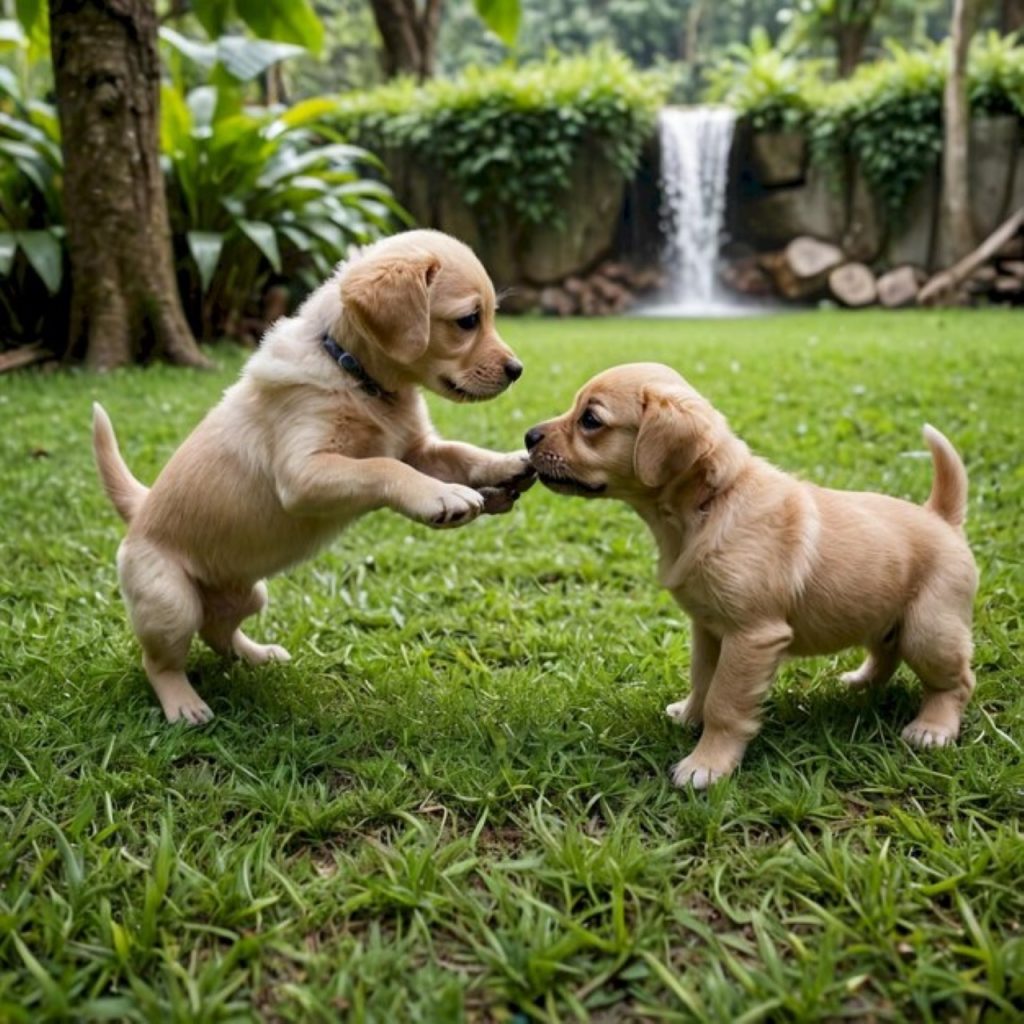
Socialization for blind dogs requires a thoughtful approach that emphasizes safety and positive experiences while helping them navigate the world through their other senses.
When introducing your blind dog to new environments or social situations, start slowly and allow them to explore at their own pace. Use verbal cues and gentle touch to guide them, and reward calm behavior with treats and praise.
To enhance your blind dog’s social interaction and confidence, consider these strategies:
- Arrange controlled playtime activities with well-behaved, calm dogs.
- Use scent-based toys to encourage engagement during social situations.
- Create a safe, familiar space for your dog during group gatherings.
- Teach friends and family how to approach and interact with your blind dog.
Gradually expose your blind dog to various sounds, textures, and smells in different environments. This will help them build a mental map of their surroundings and feel more comfortable in new situations.
Remember to always supervise interactions and be prepared to intervene if your dog shows signs of stress or anxiety.
With patience and consistent positive reinforcement, you can help your blind dog develop the social skills needed to enjoy a fulfilling life.
Frequent Questions and Answers

Yes, you can involve blind dogs in agility and other canine sports. With proper training and adaptations, your blind dog can participate safely. Focus on verbal cues, touch signals, and scent markers during blind dog agility and sports training.
You’ll notice blind dogs don’t react to mirrors or reflective surfaces like sighted dogs. They can’t see their reflections, so they won’t bark or interact with them. Instead, they’ll rely on scent and sound to navigate their environment.
You’d think Labradors would ace blindness, given their retriever skills, right? Surprise! Breed adaptability varies wildly. Your pup’s personality trumps pedigree. Focus on tailored training techniques, and you’ll find any breed can adapt to sight loss with patience.
You’ll find scented toys and textured balls are excellent for your blind dog’s sensory stimulation. Try puzzle toys with hidden treats, squeaky toys for auditory engagement, and rope toys for tactile exploration. Always supervise playtime to guarantee safety.
To help your blind dog navigate stairs safely, use scented markers at the top and bottom. Attach textured strips to each step’s edge. Guide your dog with a harness, and practice slowly. Always supervise stair use for ideal blind dog safety.
Final Thoughts
Training a blind dog isn’t a walk in the park, but with patience and dedication, you’ll see remarkable progress.
Remember to focus on your dog’s strengths, using their other senses to guide them. Consistency is key in building their confidence and independence.
As you adapt training methods to suit their needs, you’ll forge an even stronger bond with your furry friend.
Keep at it, and you’ll both reap the rewards of your hard work.


